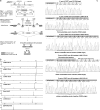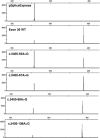CHARGE syndrome: a recurrent hotspot of mutations in CHD7 IVS25 analyzed by bioinformatic tools and minigene assays
- PMID: 29255276
- PMCID: PMC5839049
- DOI: 10.1038/s41431-017-0007-0
CHARGE syndrome: a recurrent hotspot of mutations in CHD7 IVS25 analyzed by bioinformatic tools and minigene assays
Abstract
CHARGE syndrome is a rare genetic disorder mainly due to de novo and private truncating mutations of CHD7 gene. Here we report an intriguing hot spot of intronic mutations (c.5405-7G > A, c.5405-13G > A, c.5405-17G > A and c.5405-18C > A) located in CHD7 IVS25. Combining computational in silico analysis, experimental branch-point determination and in vitro minigene assays, our study explains this mutation hot spot by a particular genomic context, including the weakness of the IVS25 natural acceptor-site and an unconventional lariat sequence localized outside the common 40 bp upstream the acceptor splice site. For each of the mutations reported here, bioinformatic tools indicated a newly created 3' splice site, of which the existence was confirmed using pSpliceExpress, an easy-to-use and reliable splicing reporter tool. Our study emphasizes the idea that combining these two complementary approaches could increase the efficiency of routine molecular diagnosis.
Conflict of interest statement
The authors declare no conflict of interest
Figures



References
-
- Bilan F, Legendre M, Charraud V, et al. Complete screening of 50 patients with CHARGE syndrome for anomalies in the CHD7 gene using a denaturing high-performance liquid chromatography-based protocol: new guidelines and a proposal for routine diagnosis. J Mol Diagn JMD. 2012;14:46–55. doi: 10.1016/j.jmoldx.2011.08.003. - DOI - PubMed
Publication types
MeSH terms
Substances
LinkOut - more resources
Full Text Sources
Other Literature Sources

